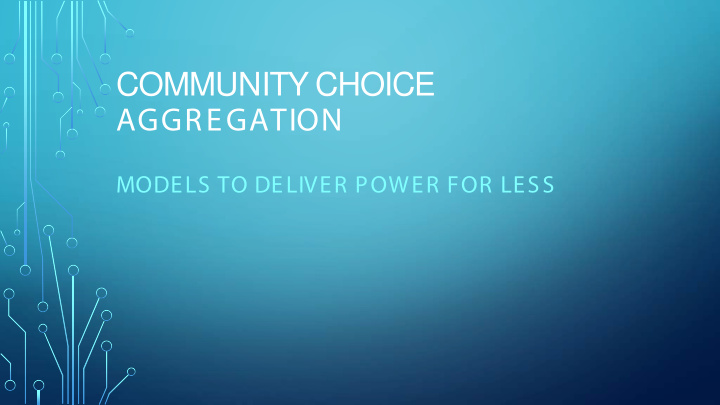



COMMUNITY CHOICE AGGREGATION MODELS TO DELIVER POWER FOR LESS
THE CONVERSATION BEGINS… … • While participating on the League Policy Committee for Environmental Quality, staff gained knowledge of a mechanism by which local governments could gain greater control of electricity costs for residential, commercial, and industrial customers within their jurisdiction. • California Assembly Bill 117 approved in 2002 established CCAs. • Public Utilities Code Sec. 366.2 lays out the rules of engagement for public agencies wishing to implement such a program.
PUBLIC UTILITIES CODE SEC. 366.2 • All customers may elect to opt out of a CCA program and stay with SCE/PG&E • All customers have the opportunity to purchase power from the CCA. • City would have to adopt an “Implementation Plan.” • City would have to file a “Statement of Intent” with the PUC, SCE, and PG&E. • City could sell power after PUC determines cost recovery from customers. • PG&E and SCE must fully cooperate with the City by continuing to provide meter reading and billing services. • City would need to sign an operating agreement with SCE and PG&E.
A PROPOSAL • Staff received a communication from PFA Energy requesting a meeting to discuss the development of a Community Choice Aggregation Model. The model outlines multiple renewable energy projects to be developed by PFA on privately owned property in Southern Hanford. • These projects would be scaled to provide enough renewable power to support new development proposals in the Hanford Industrial Park and potentially all other residential, commercial, and public agency demand at a price below that charged by SCE or PG&E.
THE MOVEMENT • CalCCA, the California Community Choice Association provides educational material on the subject. This is an association of agencies that have developed and are delivering power through one of two models currently operating in California. • The first is a J PA Model. This model includes MCE, Peninsula Clean Energy, Silicon Valley Clean Energy, and Sonoma Clean Power. • The second is a Single-J urisdiction Model. This model includes Lancaster Choice Energy and CleanPowerSF.
BEST PRACTICES ACCORDING TO CALCCA • Provides competitive electric rates and choice in service providers. • Transparent Rate Setting allows for local input. • Maintains a firewall between the assets and liabilities of the CCA program and the City’s General Fund. • Local programs that serve community interests including energy efficiency, demand response, net energy metering, feed-In tariffs, local work force development, and EV charging stations and battery storage.
A LITTLE HELP FROM OUR FRIENDS • The City of Lancaster established its Single J urisdiction CCA, known as Lancaster Choice Energy. • Lancaster and the City of San J acinto formed CCEA, which is a J PA designed to assist cities that join J PA through the process of establishing and operating CCA’s. • Formation services include the development of the “Initial Declaration to Pursue” to notify SCE, PG&E, and PUC of intentions to develop the CCA. • Development of local ordinances or resolutions making membership official and to pursue the formation of this new Legal Entity. • Establishment of the new Legal Entity which is a CCA. • Assist in feasibility studies to set rates and develop the Implementation Plan required by the PUC.
QUESTIONS? IS THIS IN HANFORD’S FUTURE?
Recommend
More recommend